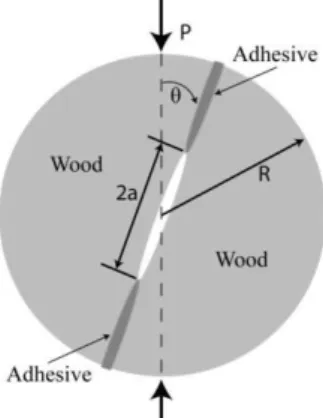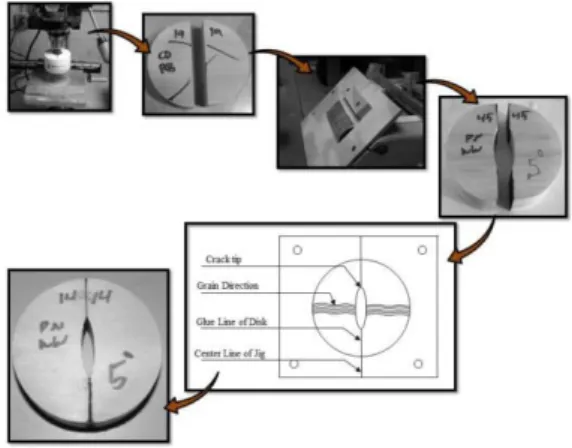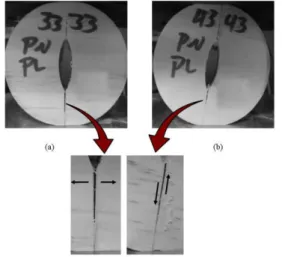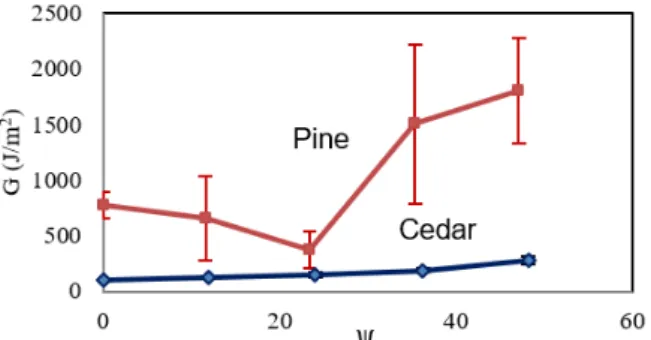EcoGRAFI
2nd International Conference on Bio-based Building Materials & 1st Conference on ECOlogical valorisation of GRAnular and FIbrous materials June 21th - 23th 2017
Clermont-Ferrand, France
MIXED-MODE INTERFACIAL FRACTURE TOUGHNESS OF WOOD AND
ADHESIVES
S. Askarinejad1, F. Shalchy1, J. Gionfriddo2, N. Rahbar1* 1 Worcester Polytechnic Institute, Worcester, MA, USA 2 University of Massachusetts, Dartmouth, MA, USA
*Corresponding author; e-mail: nrahbar@wpi.edu
Abstract
This paper presents the results of a combined experimental and theoretical study of the fracture of wood/ adhesive interfaces. Thermoplastic and thermosetting adhesives are considered in this study as well as combinations of the two applied in sequence. Mode mixity dependence of interfacial fracture toughness is measured using Brazil-nut sandwich specimens. Interfacial fracture energies, Gc, between wood and adhesives are measured over a wide range of mode mixity. Two types of woods: pine and cedar in combination with three types of adhesives: a Polyurethane adhesive, a Resorcinol based adhesive and a Phenol-Resorcinol-Formaldehyde adhesive are investigated in this study. The results show that interfacial fracture toughness generally increases with the increase in mode mixity. The trends in the overall fracture energies are also predicted using fracture mechanics models. The mode mixity dependence of interfacial fracture toughness will also be explained using a crack-shielding model that accounts for the crack profiles and the contact between mating asperities. The goal of this research is to more fully understand the interfacial toughness of wood and adhesive interfaces that exist in these types of repairs. The results can be used as a guide to design wood-based structures and furniture.
Keywords:
Wood; Adhesive; Interfacial Fracture; Brazil-nut Specimen
1 INTRODUCTION
In the Structural Engineering industry, Adhesives are widely used in the fabrication and repair of laminated wooden beams. The ability of a structural joint to maintain satisfactory long-term performance, often in severe environments, is an important requirement of a structural adhesive joint, as the joint should be able to support design loads, under service conditions, for the planned life time of the structure [Custodio 2009]. Adhesives have been studied extensively in academia [Ren 2012; Desai 2003; Somani 2003; Ates 2014; Maminski 2011]. Ren and Frazier [Ren 2012] studied polyurethane adhesives experimentally and showed that significant wood/polyurethane (PU) interactions occur during bonding. They concluded that PU studies should be conducted under conditions that simulate if not use real wood/PUR bondlines. Stoeckel et al. [Stoeckel 2013] reviewed the available literature about mechanical properties of cured wood adhesives. Yang et al. [Yang 2009] studied bio engineered adhesives using okara, a residue from the production of tofu. The adhesive resins were used to fabricate floor boards by adhering oak veneers onto high-density fiberboard. Hehl et al. [Hehl 2010] showed that it is possible to attain certain amounts of ductility in timber by using an
adhesive that exhibits plastic properties which would allow timber to fail with more warning as opposed to failing in a brittle fashion as has been previously observed. Other than wood, adhesives can be used to prevent fracture in other systems. Rahbar et al. [Rahbar 2010] presented their results of a combined experimental and theoretical study of the fracture of marble and adhesive interfaces.
The adhesive/wood interface fractures and generally most of the fractures happen under mixed-mode loading [Askarinejad 2015]. Due to the multiaxial nature of stresses, failure in adhesive/wood interfaces can happen in different ways. Mode I (crack opening or pure tension failure), mode II (in plane shear or pure shear failure) or as is most commonly observed, a combination of the two which is called mixed mode failure, where both tension and shear forces contribute to failure. In order to simulate clinically relevant loading, it is important to measure the interfacial fracture toughness under conditions that simulate the range of mixed mode loading that can occur in the oral cavity.
Different testing methods have been applied to measure interfacial fracture toughness. Sundararaman and Davidson has done the Unsymmetric End-Notch Flexure Test, where the sample consists of a
beam-type geometry that is comprised of two materials, one top and one bottom, with a crack at one end along the biomaterial interface. The specimen is loaded in three-point bending, similar to a conventional end-notched flexure test [Sundararaman 1998]. They also applied the Unsymmetric double cantilever beam test to test for interfacial toughness [Sundararaman 1997]. The test specimen in this study is the same constructions as described above however, here the specimen is loaded in a splitting fashion similar to that of a conventional double cantilever beam test. Guo and Weitsman demonstrated the applicability of a relatively simple test specimen formed of unlike adhesively joined double cantilever beams (UDCB) for determining the mixed mode components GI and GII of the adhesive’s fracture toughness [Guo 2001]. Morais looked into the difficulties obtaining valid measurements using the double cantilever beam (DCB) tests when performed on multidirectional laminates, a critical user of wood adhesives [Morais 2003]. His results showed that the undesired effects of residual stresses and of mode-mixity on interlaminar interfaces can be minimized. Bennati et al. [Bennati 2009] introduced a mechanical model of the asymmetric double cantilever beam (ADCB) test, usable to assess the mixed-mode interlaminar fracture toughness of composite laminates. The laminated specimen is represented as an assembly of sublaminates, each of which is modeled as an elastic beam partly connected to the other by a deformable interface, in turn considered to be a continuous distribution of elastic-brittle springs. Sun and Zheng [Sun 1996] studied the delamination characteristics of double-cantilever beam with end-notched flexure and obtained the distributions of strain energy release rate, G, at the crack fronts of double-cantilever beam (DCB) and end-notched flexure (ENF) specimens using finite element method. They found a boundary layer phenomenon in the distribution of G at the crack front. Blackman et al. [Blackman 2003] modified the tapered double cantilever beam (TDCB) tests in order to consider the effects of beam root rotation by applying analytical corrections in the calculation of adhesive fracture energies in mode I.
Despite the popularity of the cantilever beam tests in predicting interface toughness for certain materials, not all specimens can be tested in this fashion [Tracy 2003; Schuecker 2000; Modi 2004; Davidson 2011]. Brazil disk has been widely used to measure interfacial toughness for a range of materials [Bank-Sills 2000; Soares 1998; Tong 2007]. Dorogoy and Banks-Sills looked into the effect of crack face contact and friction on Brazilian disk specimens [Dorogoy 2005]. Brazil disks of glass and epoxy were tested. It was found that when the crack faces are in contact without stick zones, an increase in friction causes a decrease of the normal gap, tangential shift and stress intensity factors. When stick conditions appear in the contact zone, an increase in the coefficient of friction also results in increasing the stick zone within the contact zone .Additionally, Dong et al. [Dong 2008] investigated the effects of relative crack length and loading angle on the experimental results for cracked Brazilian disks. The analyzed results show that the precision of KI and KII are relevant on the relative crack length and the error of loading angle. Further, the recommended range of the relative crack length is between 0.4 and 0.6 [Dong 2008], which we maintain throughout the experiment. Load angle was verified during our
compression tests with a digital angle gauge to assure accuracy.
This study presents the results of a combined experimental and numerical study of the interfacial fracture between a range of adhesives and two types of wood. Brazil-nut interfacial fracture mechanics specimens are used to study the interfacial fracture between wood and different classes of adhesives. The results would be a robust guide to design best wood/adhesive combination for difference applications such as construction and furniture design.
2 MATERIALS AND METHODS
2.1 Materials
Two types of locally used structural woods: pine and cedar are considered in this study. Also, three types of adhesives: a Polyurethane construction adhesive, a Resorcinol based, water proof wood adhesive and a Phenol-Resorcinol-Formaldehyde industrial grade wood adhesive are investigated in this study.
In order to model interface failure through a range of mode mixities, the Brazilian Nut Sandwich Specimen is used. A schematic of a Brazil Disk is shown in Fig. 1.
Fig. 1: Schematic of the Brazil-Nut specimen.
The compression load (P) is applied at varying angles (θ) with respect to the Glue Line. When theta equals approximately zero we are testing pure mode I-tension. When theta equals approximately 20 degrees we are in mode II–shear. Between those angles is our mix mode condition. We used loading angles 0, 5, 10, 15 and 20 to achieve similar mixity ranges. The disk also has a predetermined crack length (2a). This crack relieves residual stress and allows us to predict where failure will initiate at the crack tip. The direction of the fibers was chosen to be perpendicular to the direction of mode-I interfacial crack growth in the sandwich specimens.
Wood grain ran perpendicular to the glue line to prevent the wood from failing before the interface fails. Although, wood being heterogeneous and non-isotropic, failure did sometime initiate in the wood, these specimens were not considered.
2.2 Experimental Procedure
Disk making procedure is shown in Fig. 2. After cutting a disk from a wood plate, it is cut in half across the grain using the band saw; a sample of the halves is shown in picture. A jig has been created to ensure a straight and equal cut. Set the fence straight and level using the notch in the jig to set the fence distance. The next step is to create the center hole with belt sander. Use jig attached to belt sander to sand oval
out of half disks. To ensure a symmetric elliptical notch centered in the specimen, flip the disk while sanding. Then a consistent and all-covering layer of adhesive to all 4 gluing surfaces, 2 per half, needs to be applied. Glue line should be aligned with center line of jig, this will prevent disk from slipping during clamping. Samples was left in glue jig per manufacturer’s specification, typically 24 hours was used. A finished glued specimen is shown.
Fig. 2: Disk making procedure.
Compression testing was performed using an MTS compression machine with a 5 kN (1.1 kip) load cell. Fig. 3 shows a typical test setup. To the right is the digital angle gauge we used to measure the loading angle. Our loading was displacement controlled with a rate of 0.02 mm per second.
Fig. 3: Test setup.
2.3 Interfacial Fracture Toughness
The Brazil-nut specimens are illustrated schematically in Fig. 1. The interfacial fracture tests were conducted in an MTS compression testing machine (Instron, Canton, MA) that was equipped with a 5kN load cell. Both load and displacement data were recorded using an automated data acquisition system. For each loading angle, the critical load at which the specimen failed was recorded. In the Brazil-nut sandwich experiment, the loading phase, ψ, is controlled by the compression angle, θ. The mode-I and mode-II stress intensity factors are given by:
𝐾𝐼= 𝑓𝐼𝑃𝐴√𝑙𝜋
𝐾𝐼𝐼= 𝑓𝐼𝐼𝑃𝐴√𝑙𝜋
where the plus sign and negative sign are for the two crack-tips, respectively. The non-dimensional calibration factors, fI and fII, are functions of the loading
angle, θ, and relative crack length, l/a. They are available in fitting polynomial forms in [7]. The corresponding interfacial fracture toughness, Gc, is given by:
𝐺𝑐= 𝐺𝐼+ 𝐺𝐼𝐼=𝐾𝐼 2+ 𝐾
𝐼𝐼2
𝐸́𝐼
Where E'I=E/(1-ν2) is the plane strain Young’s modulus
corresponding to the substrate (wood). The corresponding mode mixity, ψ, is given by:
𝜓 = 𝑡𝑎𝑛−1(𝐾𝐼𝐼
𝐾𝐼) + 𝜔 + 𝜀ln (
𝐿̂ ℎ)
where ε is a Dundurs parameter [Dundurs 1969] and ω, is the shift due to the mismatch of the of Lame’s constants of the substrate and adhesive layers. The shift parameter, ω, is tabulated in [Dundurs 1969] as a function of the elastic properties of adhesive and substrate layers, i.e. Young’s modulus and Poisson’s ratio. This shift, in the case of the adhesive/wood interface is presented in the following tables. It is important to note here that the parameter ˆL [Wang 1990], is chosen to be equal to h , the thickness of the adhesive layer. Equationes above were used to calculate the energy release rate and mode mixities for the Brazil-nut specimens that were tested. The tests were also conducted over a range of mode mixities by varying the loading angle, between 0° and 25°.
E(GPa) ν α ε ω Cedar 9.8 0.34 - - - PU 2.5 0.25 0.593 -0.075 -8 Resorcinol 7 0.25 0.167 -0.026 -1.5 PRF 3.9 0.25 0.431 -0.056 -5 E(GPa) ν α ε ω Pine 8.5 0.32 - - - PU 2.5 0.25 0.545 -0.069 -7 Resorcinol 7 0.25 0.097 -0.017 -2 PRF 3.9 0.25 0.371 -0.048 -4 2.4 Finite Element Model
To investigate the stress intensity factor in the woods, the finite element models were created. Woods show complex orthotropic mechanical properties which cause three-dimensional crack propagation in the system. Hence, finite element simulations were needed to calculate the stresses around the crack tip and consequently the crack driving forces. Two-dimensional finite element simulations were used to calculate the crack driving forces and mode mixities. The finite element simulations were carried out using the ABAQUS software package (Simulia, Providence, RI). In order to achieve good accuracy, 8-node quadratic plane strain quadrilateral elements were used for the entire mesh. Using interaction energy release rate, mode-I and mode-II stress intensity factors, and consequently, the mode mixity ψ, were computed. In order to compute accurate stresses at the crack tips collapsed 8-node quadratic quadrilateral elements were used (Fig. 4). A total of 123,356 elements and 385,321 nodes were used in the analysis. The material properties that were used in the
finite element simulations are presented in Table 1 and 2. Linear elastic fracture mechanics was assumed to analyze this model.
Fig. 4: Meshing in the finite element model.
3 RESULTS AND DISCUSSIONS
3.1 Damage Analysis
The compression test was done on the samples in different angles. The extreme cases which are the Mode I and Mode II fracture are shown in Fig. 5. The figures show how the initial existing cracks open up and cause the samples failure.
Fig. 5: Mode I and II of fracture.
The different essence of failure on the two samples shown above can be seen more closely in Figure 5. Figure 5a is tensile opening type of fracture and Figure 5b is in-plane shear type.
The other important factor needs to be consider in the fracture of the wood/adhesive interface is the surface of the failed interface. Fig. 6 shows the failure interface of PU, Resorcinol and PRF, respectively. The crack propagation “kinking” from one interface to the other can be seen in the PU samples. This crack propagation kinking can be a reason for higher interfacial fracture toughness of the wood/PU interface.
Fig. 6: Fracture surfaces of samples with (a) PU (b) Risorcinol (c) PRF adhesive
3.2 Fracture Tougness
The mode mixity dependence of the fracture toughness of wood/adhesives is presented in this section. As for many materials, the fracture toughness increases with increasing mode mixity, with the exception of the cedar/PU. The interfacial toughness values, Gc, for the latter adhesive, are essentially independent of mode mixity. The interfacial fracture toughness data of the samples that failure was mainly initiated in the substrate were not included in the results. As it is shown in these figures, the Pine/adhesive interfaces generally have higher fracture toughness. Moreover, for smaller angles (fracture mode I), PU adhesives behaves tougher than the other adhesives, for both types of wood. In mode II fracture, Resorsinol adhesive behave relatively tougher that the other two adhesives.
Fig. 7: Interfacial fracture toughness of cedar/adhesive
These results show that the cedar/PU samples are tougher in mode I fracture that the mode II fracture, which can be due to the crack propagation kinking shown in damage analysis part.
Fig. 8: Interfacial fracture toughness of pine/adhesive
The summarized results for the pine/adhesive interface show the almost similar trend, however the numbers are higher for the pine/adhesive interface than the cedar/adhesive interface. Another factor needs to be considered in the calculations and interpreting the results is the fracture toughness of the woods themselves vs. the mode mixity. The woods behavior is important because the crack may propagate in the wood not in the interface.
Fig. 9: Interfacial fracture toughness of pine and cedar perpendicular to their fiber orientation
4 SUMMARY
Using numerical techniques and the experimental methods, the mode mixity interfacial fracture toughness of wood and adhesives were found and the results show that interfacial fracture toughness increases with the increase in mode mixity. The trends in the overall fracture energies are also predicted using fracture mechanics models. The results indicate that the glues are stronger at mode one than mode two of fracture, and PRF adhesive shows lower fracture toughness than the other glues. Moreover the finite element models and the experiments on the woods themselves show that the overall mode mixity fracture toughness of the Pine wood is higher than Cedar.
5 REFERENCES
Askarinejad, S., Kotowski, P., Youssefian, S., & Rahbar, N. (2016). Fracture and mixed-mode resistance curve behavior of bamboo. Mechanics Research Communications, 78, 79-85.
B. Ates, S. Koytepe, M. Karaaslan, S. Balcioglu and S. Gulgen, "Biodegradable non-aromatic adhesive polyurethanes based on disaccharides for medical applications," International Journal of Adhesion and Adhesives, vol. 49, pp. 90-96, 2014.
L. Banks-Sills, N. Travitzky and D. Ashkenazi, "Interface fracture properties of a bimaterial ceramic composite," Mechanics of Materials, vol. 32, no. 12, pp. 711-722, 2000.
S. Bennati, M. Colleluori, D. Corigliano and P. Va, "An enhanced beam-theory model of the asymmetric double cantilever beam (ADCB) test for composite laminates," Composites Science and Technology, vol. 69, no. 11–12, pp. 1735-1745, 2009.
B. Blackman, . H. Hadavinia, A. Kinloch, M. Paraschi and . J. Williams, "The calculation of adhesive fracture energies in mode I: revisiting the tapered double cantilever beam (TDCB) test," Engineering Fracture Mechanics, vol. 70, no. 2, pp. 233-248, 2003.
J. Custodio, J. Broughton and H. Cruz, "A review of factors influencing the durability of structural bonded timber joints," Adhesion and Adhesives, vol. 29, no. 2, pp. 173-185, 2009.
B. Davidson and F. Sediles, "Mixed-mode I–II–III delamination toughness determination via a shear– torsion-bending test," Composites Part A, vol. 42, pp. 589-603, 2011.
S. Desai, J. Patel and V. Sinha, "Polyurethane adhesive system from biomaterial-based polyol for
bonding wood" International Journal of Adhesion and Adhesives, vol. 23, no. 5, pp. 393-399, 2003.
S. Dong, "Theoretical analysis of the effects of relative crack length and loading angle on the experimental results for cracked Brazilian disk testing," Engineering Fracture Mechanics, vol. 75, pp. 2575-2581, 2008. A. Dorogoy and L. Banks-Sills, "Effect of crack face contact and friction on Brazilian disk specimens—A finite difference solution," Engineering Fracture Mechanics, vol. 72, no. 18, pp. 2758-2773, 2005. J. Dundurs. Discussion:“Edge-bonded dissimilar orthogonal elastic wedges under normal and shear loading”, Journal of applied mechanics, 36(3), 650-652, 1969.
Y. Guo and J. Weitsman, "A modified DCB specimen to determine mixed mode fracture toughness of adhesives," Engineering Fracture Mechanics, vol. 68, no. 15, pp. 1647-1668, 2001.
S. Hehl, T. Valle, T. Tannert and Y. Bai, "A probabilistic strength prediction method for adhesively bonded joints composed of wooden adherends," Key Engineering Materials, vol. 417, pp. 533-536, 2010.
M. Maminski, P. Parzuchowski, A. Trojanowska and S. Dziewulski, "Fast-curing polyurethane adhesives derived from environmentally friendly hyperbranched polyglycerols – The effect of macromonomer structure," Biomass and Bioenergy, vol. 35, pp. 4461-4468, 2011.
M. Modi and S. Sitaraman, "Interfacial fracture toughness measurement for thin film interfaces," Engineering Fracture Mechanics, vol. 71, no. 9–10, pp. 1219-1234, 2004.
A. Morais, "Double cantilever beam testing of multidirectional laminates," Composites Part A: Applied Science and Manufacturing, vol. 34, no. 12, pp. 1135-1142, 2003.
N. Rahbar, M. Jorjani, C. Riccardelli, G. Wheeler, I. Yakub, Ting Tan and . W. Soboyejo, "Mixed mode fracture of marble/adhesive interfaces," Materials Science and Engineering: A, vol. 527, no. 18–19, pp. 4939-4946, 2010.
F. Stoeckel, J. Konnerth and W. Gindl-Altmutter, "Mechanical properties of adhesives for bonding wood—a review,," International Journal of Adhesion and Adhesives, vol. 45, pp. 32-41, 2013
V. Sundararaman and . B. Davidson, "An unsymmetric double cantilever beam test for interfacial fracture toughness determination," Solids and Structures, vol. 34, no. 7, pp. 799-817, 1997
J. Tong, K. Wong and C. Lupton, "Determination of interfacial fracture toughness of bone–cement interface using sandwich Brazilian disks," Engineering Fracture Mechanics, vol. 74, no. 12, pp. 1904-1916, 2007 G. Tracy, . P. Feraboli and K. Kedward, "A new mixed mode test for carbon/ A: Applied Science and Manufacturing, vol. 34, no. 11, pp. 1125-1131, 2003 Wang, J. S., & Suo, Z. (1990). Experimental determination of interfacial toughness curves using Brazil-nut-sandwiches. Acta Metallurgica et Materialia, 38(7), 1279-1290.
I. Yang, S. Ahn, I. Choi, H. Kim and S. Oh, " Adhesives formulated with chemically modified okara and phenol– resorcinol–formaldehyde for bonding fancy veneer onto high-density fiberboard," Journal of Industrial and Engineering Chemistry, vol. 15, pp. 398-402, 2009.



